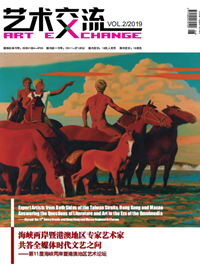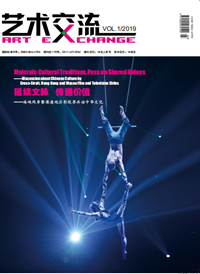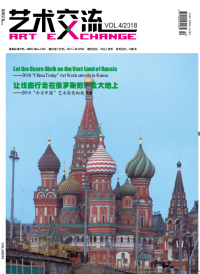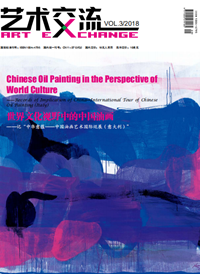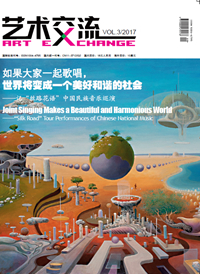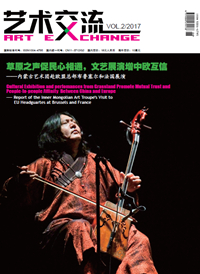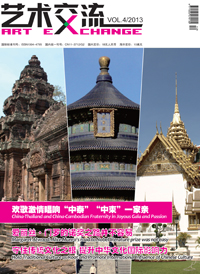Discussion of the Four Great Painters of Ming Dynasty

North Sea (Oil Painting) YAN Wenliang
Initiated as a cross-time dialogue between the ancient and the present paintings of the Wu School, "Looking back 600 Years---From Four Great Painters of Ming Dynasty to the Present Wu School special painting exhibition hosted by National Art Museum of China, Publicity Department of Provincial Government of Jiangsu, Federation of Literature & Art of Jiangsu, Government of Suzhou City has been held at NAMOC from 30, November to 10, December. The exhibition displays 164 artworks, including the Chinese painting, oil painting, engraving, watercolor painting etc., demonstrating the artistic style of the Wu School represented by the Four Great Painters of Ming Dynasty. This article by SHAN Guoqiang, a researcher of the Palace Museum, is committed to showing such artistic characteristics as comprehensive inclusiveness, diversified combination, refined implication and aesthetic tradition in the art works of the region.
As a globally-renowned ancient city of history and culture, Suzhou, since the foundation during the Wu Dynasty in the Spring and Autumn Period, has a history of over 2,500 years with profound cultural heritage. The city has even become the national center of agriculture, industrial and commercial economy, culture and art Over a period of nearly five centuries during the Ming and Qing dynasties, and the main features of its cultural and artistic prosperity lie in the aspects of strong comprehensive strength, complete categories and continuous development. Suzhou is mostly famous as a city of arts and crafts, showcasing the magnificent fine embroidery, one of China’s most famous four embroideries, jade carving reputed for the Extraordinary Skills, Taohuawu woodcut New Year painting, one of the three major folk schools of its kind, unparalleled picture mounting, the changing Suzhou fans, lively Huqiu clay figurines, elegant Suzhou-styled furniture, exquisitely-carved small pieces of mahogany and tapestry, properties, folk musical instruments etc. It also earns the reputation of garden city, "Half City Covered by Gardens", showing over 270 gardens in the Ming dynasty and more than 130 during the Qing dynasty according to the statistics. Suzhou is also the homeland of China’s best academicians, with 26 scholars in the Qing dynasty, accounting for 22.8% of the country’s total number. More importantly, Suzhou is a great city of poetry, literature, calligraphy and painting, with Four Great Men of Wu during the Ming dynasty, GAO Qi, YANG Ji, ZHANG Yu and XU Ben, Four Talents of Wu, WEN Zhengiming, TANG Yin, ZHU Yunming and XU Zhenqing, light literature writer, FENG Menglong, literary critic, JIN Shengtan, dramatist LI Yu amongst others. Famous experts of painting and calligraphy of Wu School emerged continuously during the middle and later period of the Ming dynasty, including SHEN Zhou, WEN Zhengiming, TANG Yin and QIU Ying, Rwown as Four Great Figures of Wu School as well as WEN Jia, WEN Boren, LU Zhi, QIAN GU, ZHOU Tianqiu, LU Shidao and other painters of Wu School created by SHEN Zhou and WEN Zhengming, Three Great Calligraphers of Wu School ZHU Yunming, WEN Zhiming and WANG Pang, the Songjiang School of painting circle headed by DONG Qichang emerged during the late Ming and early Qing dynasty, WANG Shimin, WANG Jian, WANG Hui and WANG Yuanqi, the Four WANGs School, and the Loudong School, Yushan School and others created by them have enjoyed much popularity until late Qing dynasty and the early Republic of China.
A group of painters from southern China centered around Suzhou emerged from the year of Chenghua to Jiajing (1465-1566) during the middle Ming dynasty. Replacing the Yuan School and Zhe School of early Ming dynasty, they dominated the painting circle for nearly a century, represented by the Four Great Figures of Wu School, SHEN Zhou, WEN Zhengiming, TANG Yin and QIU Ying, and other painters of Wu School created by SHEN Zhou and WEN Zhengming. The disciples and followers of these famous painters have reached over a hundred, creating the largest school of painting in the Ming dynasty.
Suzhou area had already gathered a number of well-known painters before the sudden rise of Wu School. They had mostly inherited the tradition of the literati painting of the Four Painters of Yuan Dynasty, represented by XU Ben, XIE Jin and WANG Fu at earlier time as the transitional figures between Yuan and Ming dynasties, and DU Qiong, LIU Jue, YAO Shou, SHEN Zhenji, SHEN Hengji and others following later cast direct influence towards SHEN Zhou, founder of Wu School. Hence, this group of literati painters was known as the predecessor of Wu School.
Of the Four Great Figures of Wu School, SHEN Zhou was the oldest, WEN Zhiming as his student, with his influence to TANG Yin. Under the family influence by his uncle SHEN Zhenji and his father SHEN Hengji and personal instruction by his teacher DU Qiong and LIU Jue at early years, SHEN Zhou had initially accepted the tradition of literati painting dominated by the Four Great Painters of Yuan dynasty. At early days before the age of 40, he mainly studied from WANG Meng while absorbed knowledge from DONG Yuan and JU Ran, with his artworks showing complex landscape and rigorous structure, sharp drawing technique and refined and meticulous style, earning him the reputation of XI SHEN in history. From the age of 40 to 58, he generally turned to the style of CU SHEN by studying from all painters with main model of HUANG Gongwang, transforming from the exquisite and refined small scenery to the crude large extension while integrating all the advantages of other great painters. His most favorite was DONG Yuan, JU Ran, LI Cheng and four great painters in Yuan dynasty. The selected Landscape Scroll by Imitation of DONG Yuan and JU Ran, drawn at the age of 47, reflects the phase of XI to CU transition. SHEN Zhou called himself Bai Shi Weng. Hence, the 20 years after this period can be considered the later period, during which he was obsessed with WU Zhen with rough and heavy style, hearty use of ink with rendering by wet brush and changes of shade, creating vastness from simplicity and reaching the perfection in landscape painting by thick brush, such as the selected Scroll of Cangzhou Landscape, the representative work of his old age.
WEN Zhengming and SHEN Zhou jointly created the Wu School. Wen's landscape paintings are divided into three phases, the early phase was from the age of 30 to 44, as his original given name was Bi, changing to Zhengiming at 42 and eventually giving up the Bi. Hence, it could be the early phase before the name change. During this period, he acknowledged SHEN Zhou as his teacher, while learning from ZHAO Mengfu and WANG Meng with exquisite style in both green landscape painting and water landscape painting, namely Xiwen. He learned the green landscape painting primarily from ZHAO Mengfu, combining ZHAO Boju and ZHAO Bosu and integrating with styles of four great painters of Yuan dynasty, MI Youren and MI Fu, forming the colorful and charming green landscape style of small size. His water landscape painting, on the other hand, borrowed WANG Meng’s deliberation, HUANG Gongwang’s imagination and ZHAO Mengfu’s refinement, constituting the pretty and smooth genre.The Scroll of Yilanshi created at age of 60 is a reflection of such appearance. Moreover, being skillful in both thick and thin styles at his late period between the age of 60 to 90, he showed more vigorous efforts in thin style and harsh taste in thick strokes. Due to the greater influence in the Painting Style of Wu School, WEN Zhengiming possessed more followers.
Quite different from SHEN Zhou and WEN Zhiming, TANG Yin and QIU Ying were not pure literati painters and members of Wu School accordingly. Born in a family of merchant, TANG Yin studied poems at his youth with great talent and made friends with WEN Zhengiming, ZHANG Ling, DU Mu, XU Zhenqing and other literati. Having claimed the first place in the imperial exam at the provincial level at the age of 29, he was a typical scholar. Influenced by the fraud in the metropolitan examination in the capital, he started to sell paintings for a living after giving up his official career and became a professional painter afterwards. Hence, his style is compatible with the features of literati and professional paintings. Having showed comprehensive skills in painting, he was accomplished in landscapes, figures, flowers and birds in style, and traditional Chinese realistic painting, freehand painting, line drawing, ink painting with consummate skills by diversified colors in techniques. Concerning the landscape painting, under the influence of SHEN Zhou and WEN Zhiming and other literati painters of Wu School during the early period before the age of 30, TANG Yin followed the traditions of artists of Yuan Dynasty. After becoming a professional painter during the middle period from age of 30-40, he once learned from ZHOU Chen, an elder painter focusing on the Imperial-Court Painting School of Southern Song dynasty with vigorous style amid characteristics of delicacy and exquisiteness of the early period. During the late period from age of 40-54, he gradually formed the genuine style of refined natural landscape, integrating characteristics of both northern and southern parts of the country, as commented by SHENG Dashi in his Admiring Mountain Scenery by Springs : TANG Yin had true spiritual style learning from the south, but not north. His classic style: simple scenery, highlighting the close shot and brief distant view; combining vigor and suppleness in strokes power; the changing Cunfa featuring miscellaneous and orderly lines in a number of diversified strokes; the dripping ink showing different levels, full coverage in frame with sense of smoothness and intangibility. The Scroll of Double Rocks created at the age of 50 reflects his typical image of refined style during the late period. The Volume of Shiming shows comprehensive techniques, lake, stone and pines in close range by imitation of LIGUO School of the Northern Song dynasty, the distant mountains adopt strokes of XIA Gui of Southern Song dynasty, and the house and slopes centering the frame follow the style of painters of Yuan dynasty and WEN Zhiming, resulting the frame categorized from the transitional phase of middle and later period.
Born poor, QIU Ying pursued painting during after lacquering work his youth by considering ZHOU Chen as teacher, hence, he is the fellow apprentice of TANG Yin. Initially in the style of Yuan School of Southern Song dynasty specialized by years of ZHOU Chen, he then got acquainted with WEN Zhiming, poets of Wu and literati painters WANG Shou, WANG Chong, WEN Peng, WEN Jia, WEN Boren, PENG Nian, LU Zhi, LU Shidao, ZHOU Tianqiu and others, and was deeply influenced by the Wu School, changing style from vigorousness to exquisiteness in a gradual manner. During his middle age, he once lived in the mansion of XIANG Yuanbian, a great collector, for over a decade followed by painting at ZHOU Liuguan’s residence, a collector in Kunshan, enjoying their large collection of a number of famous artworks of Song and Yuan painters, improving his painting technique especially in green mountains and waters, and Chinese realistic painting personage. Copy of Xiaozhao's Painting in Praise of Emperor Gaozong's Glory in Song Dynasty is his artwork, faithful to the original ancient style, as the complete six scenes are capable of complementing the missing original works of XIAO Zhao, a famous painter of Song dynasty. QIU Ying and TANG Yin are called the painters of integration of both professional painting and literati painting. Having not formed a school, yet they have enjoyed the same reputation as that of SHEN Zhou and WEN Zhengiming with many followers, as their artworks were most popular amongst all people.
The Wu School, created by SHEN Zhou and WEN Zhengiming, has followers of many generations. SHEN Zhou possessed a large number, including his offspring SHEN Bin, SHEN Zhao, SHEN Zhen, SHEN Si, SHEN Luzhou, SHEN Hao, SHEN Mei amongst others, apprentices and followers WEN Zhengiming, ZHANG Fu, XIANG Cheng’en, SHENG Shitai, WU Qi, ZHOU Yong, LEI Li, CHEN Duo, CHEN Huan, LU Wen, YU Xilian, SUN Ai, ZONG Zhou, XIE Shichen, CHEN Tianding, DU Yilong, ZHU Nanyong, LI Zhu, XU Hongze etc. Of all, WEN Zhengiming was the best with favorable reputation of "Outstanding Painter of Orchids", while XIE Shichen, also famous for his own creativity, was skilled in landscape painting on giant frame, showcasing magnificent and well-known mountains and rivers with free strokes and shallow colors borrowed from SHEN Zhou’s vigorous force and boundless potential, featuring great exposure as that of Zhejiang School. The Scroll of Thinking by Spring and Pavilion reflects his typical style accordingly.
After the pupils of SHEN Zhou and WEN Zhengiming, the Wu School witnessed a gradual declination as the following artworks remained unchanged without much creativity, as it was commented in Scroll of Mountain and Water of DU Qiong by FANG Jiou of Qing dynasty: both great masters and poor hands were from the Wu School in the Ming dynasty. However, during the late Ming, a group of painters closing to the Songjiang School, by the influence of DONG Qichang in painting circle in Suzhou, have claimed certain achievement, including SHAO Mi, BIAN Wenyu amongst others. It also cradled some portrayed painters who depicted the secular life of the city, such as LI Shida, YUAN Shangtong and ZHANG Hong, whose style has again injected fresh air and vitality into the Suzhou painting circle.
We can appreciate its profound cultural background and abundant cultural connotation only through the field of painting to observe the historical development of Suzhou in the past five hundred years, showing successive generations of great masters, a reflection of the long and splendid culture of the former Wu state. Adapting the ancient forms for the present-day use, the spread, summary, research and inheritance of Wu culture shall undoubtedly make a useful contribution to the cultural construction of Suzhou in the new period.



